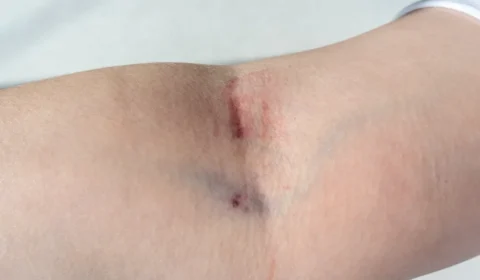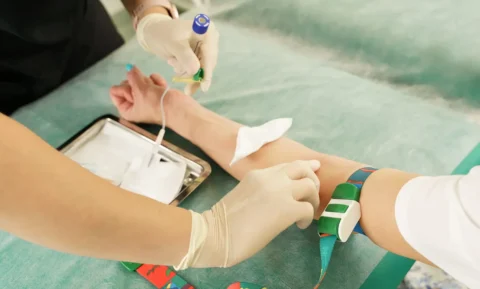Botox is one of the simplest cosmetic procedures that any patient can get from a med spa. As a non-surgical treatment, this injectable is relatively easy to administer; however, it does require precise injection techniques and knowledge of facial anatomy. While there are basic aesthetic medicine modules that you can use to gain new skills from home, Botox is not a procedure that anyone can learn at home.
So why is DIY Botox training not recommended? While it’s tempting to watch Botox training videos on your own, they’re not enough to give you a comprehensive overview of the treatment and provide the skills required to perform safe and successful procedures. Botox should always be given by a medical professional who’s received proper certification and completed a facial aesthetic course.
Can You Do Botox Training On Your Own?
Botox is a widely loved and popular injectable treatment for patients of different ages. This cosmetic injection works exceptionally well for smoothing the appearance of facial wrinkles and fine lines. Along with dermal filler injections, Botox is one of the most in-demand procedures in many med spas.
However, not just any practitioner can perform this treatment in an aesthetic practice. To be able to legally and safely administer Botox injections, a provider should have an active medical state license and obtain the necessary certifications. You can’t simply earn the proper skills and experience by practicing and learning Botox on your own.
Botox is a neuromodulator injection that works by relaxing the overactive facial muscles that cause a wrinkle to form on the skin. Depending on where the wrinkles are visible, it requires precise injections on specific muscles for them to be effectively eliminated. A Botox injector should be able to determine the sites where the botulinum toxin will be applied and that means they need to have adequate knowledge and understanding of facial anatomy.
Compared to DIY training where you teach yourself about the injections, a Botox course is usually given by certified instructors who’ll explain everything you need to know about botulinum toxin treatments—from preparation, correct dosing and units, common injection areas, patient selection and assessment, and hands-on practice.
Why You Should Never Do DIY Botox Training
It’s the responsibility of aesthetic providers to give their clients a safe cosmetic injection experience. Without proper Botox training and practice, there can be serious effects and consequences for both the patient and the injector. Here are some reasons why you should not get DIY training:
1) Irreversible Botox results
Compared to a dermal filler which can be easily reversed, Botox can’t be undone once it’s injected into the facial muscle. If the results are not what the patient expected, it’s hard to undo the treatment and they’d have to wait until the neurotoxin is out of their system. You can lessen the risk of giving bad results by injecting Botox in the appropriate places.
2) Potential adverse complications
Although it’s a cosmetic treatment, Botox is still a prescription medicine that should be used by trained professionals. Proper training is needed to know how many doses should be given to treat a specific type of wrinkle.
If a patient receives an incorrect dose, there’s a risk of having adverse side effects such as difficulty breathing, headaches, trouble swallowing, or muscle weakness. A provider should also know how to examine a patient and determine if they’re a good candidate for the treatment. Some patients may be allergic to the toxin which may lead to allergic reactions after the procedure.
3) May Lead to a Violation of State Rules and Regulations
Some states have certain requirements as to who can perform Botox treatments. It’s recommended that your injectors receive proper Botox training to ensure that your practice is complying with state laws. Attending Botox courses is also a good way to keep your providers up-to-date with the latest techniques in neuromodulator injections.
Common Mistakes That Can Happen With No Prior Botox Training
Even though Botox is a simple procedure, there are still some mistakes that can happen if you don’t know how to properly administer them. Here are some of the things that can go wrong if you have no professional Botox training:
1) Incorrect Botox Units
It’s crucial to know the right amount of Botox units that should be injected which will effectively get rid of wrinkles and provide natural-looking results. Placing too little Botox may not have any effects on the skin, while injecting excessive amounts of Botox may cause a frozen face appearance or lead to overarching or drooping eyebrows.
Before the procedure, you should assess the patient and prepare the injections according to the severity of their concern. Generally, the recommended doses for Botox injections are:
- Crow’s feet – 12 to 30 Botox units
- Glabellar lines – 20 to 40 Botox units
- Forehead wrinkles – 15 to 30 Botox units
2) Wrong Injection Areas
An understanding of the facial anatomy is pertinent to avoid injecting Botox in the wrong places. It’s important to know what muscles are related to the different types of wrinkles so you don’t make the mistake of choosing incorrect injection sites. Identifying the facial muscle can be confusing, especially since they’re close to each other. Here are some of the common Botox injection mistakes related to facial muscles:
- In treating frown lines or glabellar wrinkles, some injectors may place Botox into the frontalis muscles instead of the corrugator supercilii muscle which could lead to the appearance of a peaked or overly arched brow.
- Another reason for having an elevated eyebrow after Botox is when the injections are placed in the superior lateral portion of the orbicularis oculi muscle.
- Some patients may also experience eyebrow or eyelid ptosis when Botox it’s wrongly injected into the frontalis muscle.
- When treating crow’s feet, be careful not to inject too low in the orbicularis oculi muscle since it may aggravate the appearance of undereye bags.
3) Unfamiliarity With Patterns of Facial Muscle Contractions
Aside from knowing the facial anatomy, you should also be aware of the patterns of muscle contractions which cause wrinkle formation. This may differ among patients so it’s necessary to conduct a thorough assessment to know their individual muscle contraction activity. This will help you customize the Botox treatment so you can give a more natural result.
4) Use On Wrong Type of Wrinkles
Typically, a Botox cosmetic procedure is done on dynamic wrinkles or those that form from years of facial expressions and muscle movement. You should evaluate whether the patient’s wrinkle concern is from muscle contractions or due to sagging skin and loss of volume. In cases of static wrinkles, hyaluronic acid filler treatments may be better at eliminating them.
The Right Way to Learn Botox Treatments
There are plenty of online medical aesthetics and Botox courses with CME credits that you can take to enhance your cosmetic injectable skills. These courses are available to anyone who may be allowed to administer Botox treatments including:
- Licensed medical professional, physician, or skincare specialist
- Physician assistant
- Nurse practitioner
- Dentist
- Plastic surgeon
To obtain a Botox certification, you need to apply to a training program which may take up to 2 weeks to complete. You may also be required to log in a certain amount of practice hours before you can perform the treatment in a med spa setting on your own. Normally, you’d need to have an active state license to qualify for the training course. It’s important to select an advanced Botox training program that offers hands-on training taught by expert instructors.
What You’ll Learn In A Botox Training Course
Although there are different Botox training programs available, the topics covered are almost the same and they can include the following:
- Understanding the differences and similarities between the kinds of botulinum toxin products (Botox, Dysport, Xeomin, and Jeuveau)
- Knowing how to store, dilute, and prepare the injections
- Knowing the criteria for assessing and diagnosing patients
- Understanding how botulinum toxin injections affect the facial muscle
- Protocols on patient safety and injection procedure
- Managing possible post-injection side effects and complications
- Knowing how to provide combination treatments such as Botox with lip filler or Botox and filler for nasolabial folds
- Practical advice and support on how to market or advertise your Botox services
What’s Next After Completing Your Botox Training: Tips for Successful Injections
Upon finishing your training and getting the required practice hours, you will be qualified to provide the injections in your practice. However, check your state regulations since some areas require that physician assistants and nurse practitioners must be supervised by a licensed physician during the Botox cosmetic procedure.
You should diligently apply your learning in practice to make sure to administer Botox safely. Here are other reminders to help you perform effective Botox injections:
- During the initial consultation with a patient, make sure to properly evaluate their condition and determine that they’re a good candidate for the treatment.
- Know which type of botulinum toxin will work best for their cosmetic or medical issues.
- Use only medical-grade and sterile tools for the injection procedure.
- Identify and mark the injection sites where you’ll place the neurotoxin product.
- Prepare an ice pack for the patient so it’s easy to manage the swelling and bruising after the treatment.
- Remind patients of Botox aftercare instructions so they will get the best outcome from the injections.
Shop Educational Courses and Medical Tools for Botox Injections from FACE Med Store
There’s no certainty that you’ll be able to learn all that you need to know from DIY Botox training. If you want to improve your staff’s competence and ability in injectable treatments, it’s better to sign up for accredited courses and programs.
At FACE Med Store, we offer online training courses on different topics such as the basics of facial aesthetic medicine, neuromodulator injections, and dermal filler treatments. We also provide high-quality, affordable medical tools and supplies for your practice. Contact us now to know more about our products or inquire about our stock list.






